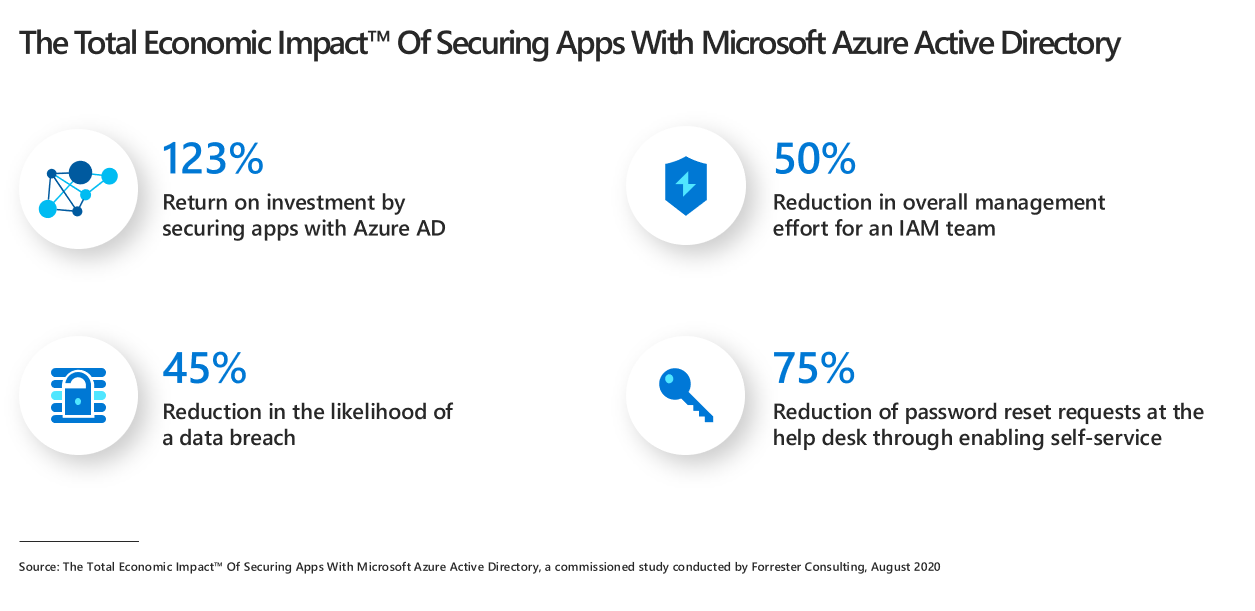Over the past six months, organizations around the world have accelerated digital transformation efforts to rapidly enable a remote workforce. As more employees than ever access apps via their home networks, the corporate network perimeter has truly disappeared, making identity the control plane for effective and secure access across all users and digital resources.
Businesses have responded to the pandemic by increasing budgets, adding staff, and accelerating deployment of cloud-based security technologies to stay ahead of phishing scams and to enable Zero Trust architectures. But the pressure to reduce costs is also real. Given COVID-19 and uncertain economic conditions, many of you are prioritizing security investments. But how should you allocate them? According to a new study, The Total Economic Impact™ of Securing Apps with Microsoft Azure Active Directory, investing in identity can not only help you accelerate your Zero Trust journey, it can also save you money and deliver more value. In this commissioned study, Forrester Consulting interviewed four customers in different industries who have used Azure AD for years. Forrester used these interviews to develop a composite organization. They found that customers securing apps with Azure AD can benefit from a 123 percent return on investment over three years in a payback period of six months.

The customers interviewed improved user productivity, reduced costs, and gained IT efficiencies in the following areas[1]:
Increased worker productivity with secure and seamless access to all apps
Employees expect to collaborate on any project from anywhere using any app—especially now, when so many are working from home. But they find signing into multiple applications throughout the day frustrating and time-consuming. When you connect all your apps to Azure AD, employees sign in once using single sign-on (SSO). From there, they can easily access Microsoft apps like Microsoft Teams, software as a service (SaaS) apps like Box, on-premises apps like SAP Hana, and various custom line-of-business apps. Forrester estimates that consolidating to a single identity and access management solution and providing one set of credentials saves each employee 10 minutes a week on average, valued at USD 7.1 million over three years.
“Our CIO really didn’t like that anybody onboarding with our company was receiving—and this is not an exaggeration—two dozen credentials. In the executive branch, they took up to two weeks to get a new hire on their feet.” –Director of workplace technology, Electronics
Reduced costs by reducing the risk of a data breach
A data breach can be incredibly expensive for victims, who must recover not only their environments but also their reputations. Breaches often start with a compromised account, which is why it’s so important to protect your identities.
With Azure AD, you can secure all your applications and make it harder for attackers to acquire and use stolen credentials. You can ban common passwords, block legacy authentication, and protect your privileged identities. You can implement adaptive risk-based policies and enforce multi-factor authentication to ensure that only the right users have the right access. Forrester found that using these Azure AD features can help organizations reduce the risk of a data breach, saving them an estimated USD 2.2 million over a three-year period.
“Conditional Access was non-negotiable as we moved to the cloud. We had to be able to apply policies that scoped applications, users, devices, and risk states. You can’t let a compromised user walk into a cloud app anymore. It’s unacceptable.” –Information security services, manufacturing
Empowered workers to reset their own passwords
If you have a help desk, your employees likely make thousands of password reset requests per month. Locked out users can’t be productive, and their pleas for help eat up valuable time help desk workers could spend on other priority tasks. One organization told Forrester it costs them between USD500,000 and USD700,000 per year just to reset passwords.
With Azure AD Self-Service Password Reset, employees can reset their own passwords without help desk intervention. Forrester estimates that with this feature, customers can decrease the number of password reset calls per month by 75 percent, yielding a three-year adjusted present value of USD 1.7 million.
Unlocked efficiency gains by consolidating their identity infrastructure
Many enterprises use several solutions to manage identity and access management: an on-premises solution for legacy applications, a SaaS-based solution for modern cloud applications, and Azure AD for Microsoft applications. Maintaining this complex infrastructure requires multiple servers and licenses, not to mention people who understand the various systems. Migrating authentication for all your apps to Azure AD can significantly reduce hardware and licensing fees. Forrester estimates savings at a three-year adjusted present value of USD 1.9 million.
Consolidating your identity infrastructure to Azure AD gives you the benefits of cloud-based identity and access management solutions and frees your team to focus on other priorities. IT and identity teams in the study reduced time and effort spent provisioning/deprovisioning accounts, integrating new applications, and addressing issues related to IAM infrastructure. They also experienced less system downtime. Forrester estimated the value of IT efficiency gains at USD 3.0 million over three years.
Integrating with Azure AD also benefits software vendors
As part of the TEI, Forrester interviewed two Independent Software Vendors (ISVs), Zscaler and Workplace from Facebook. They documented their findings in the spotlight, Software Vendors Boost Adoption by Integrating Their Apps with Microsoft Azure Active Directory. Integrating their applications with Azure AD helped the two ISVs interviewed accelerate their sales cycles, as well as product adoption. Seamless integration with Azure AD helps ISVs reach the more than 200,000 organizations that use Azure AD. ISVs can easily give their customers and prospects single sign-on, automated user provisioning, and enhanced security through the security features built into Azure AD, while focusing their energies on enhancing their own solution.
“There is a shorter sales cycle for our platform. Many of our customers are already AD FS-based users, and our integration with Azure AD makes the case for our services that much more compelling. It also allows us to be more agile in helping customers get things implemented more quickly. Essentially, there’re fewer barriers to entry for customers.” – Vice President, product management, Zscaler
“We have a strong mutual customer base with Microsoft, which is why we’ve built such a great partnership with them over the years. Obviously, Azure AD is widely used by our customers, so it makes sense to leverage it.” – Platform Partnerships Manager, Workplace from Facebook
Learn more
COVID-19 has ushered in a new normal of remote work and conservative budgets, but that doesn’t mean you have to sacrifice security or the user experience. By integrating all your apps with Azure AD you can add value—like giving your employees a more convenient and secure work from home experience—while preserving valuable resources.
Find out how Azure AD can help secure all your apps and read the full Forrester Consulting study, The Total Economic Impact™ of securing apps with Microsoft Azure Active Directory and Software vendors boost adoption by integrating their apps with Microsoft Azure Active spotlight.
To learn more about Microsoft Security solutions visit our website. Bookmark the Security blog to keep up with our expert coverage on security matters. Also, follow us at @MSFTSecurity for the latest news and updates on cybersecurity.
[1] Forrester based all savings estimates on the composite organization developed for its TEI study.








